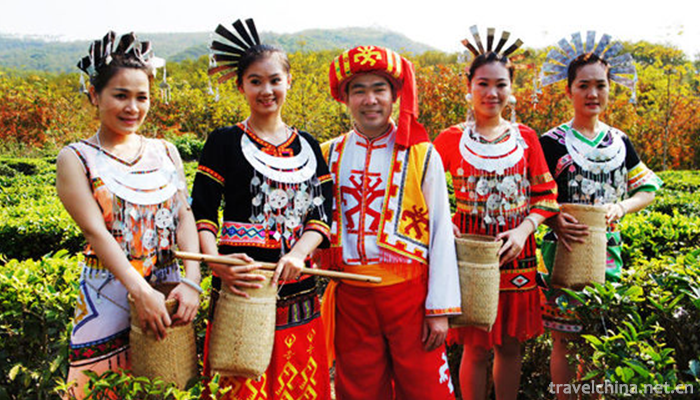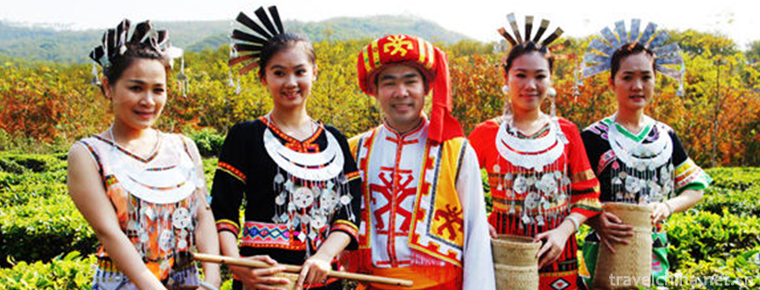Li nationality costumes
Li nationality costumes
Li costumes are mainly made of island cotton, hemp, kapok, bark fiber and silk. In ancient times, some places also used the bark of twig or bloody throat trees as clothing materials. This kind of dress material is made by cutting down the bark from the hill, removing the outer layer of skin residue by beating, leaving the fiber layer, and then soaking and drying with purple cabbage (ash burned from the shell).
Li men usually wear a pair of collarless jacket and trousers, and tie their headscarves to insert pheasant feathers. Women wear black round-collar headdress with many ornaments. The neckline is connected with white and green beads into three sets of edges. The cuffs and hems are decorated with patterns. The front and back are strung with beads in a color pattern. Wear a tight miniskirt underneath. Some wear black and blue flat-collar jackets, white embroidered cuffs, a stripe pattern on the back, a colorful flower dress with folds at the front, silver chains at the head, silver necklaces at the neck, pearl bells at the chest, and silver rings at the hands. The head is tied with a black cloth scarf.
The Li costumes declared by Hainan Jinxiu Zhibei Co., Ltd. on June 14, 2008 were listed in the second batch of national intangible cultural heritage list with the approval of the State Council. (Category: Folklore; Number: _-111)
Historical evolution
Overview
The traditional costumes of Li nationality are brilliant and colorful, and their styles and patterns have local characteristics.
Ancient
Historically, Li women in Hainan Island were skilled in textiles, dyeing and embroidery. They used island cotton, kapok, bark fiber and silk to sew clothes.
Shangshu Yugong records that "island Yihua clothes, pole weaving shellfish" refers to the situation of textiles. The Han Dynasty has "wide distribution", the Tang Dynasty has "Jibeibu", "Panban cloth", "food list" (tablecloth), to the Song Dynasty has "blue and white cloth" and so on. In Book of the Later Han Dynasty, Volume 86, Biographies of Nanman, it is recorded that at the end of Emperor Wu, Sun Xing, a member of the Zhuya Taishou Association, spread his works in a wide range, and was unable to serve, so he attacked the county and killed the fortune.
” In the middle of Tang Dynasty, Li women woven quilts, tablecloths and dish patches with "Jibei" (wild kapok) and were listed as tributes of the court. After the Song Dynasty, the cotton textile skills of the Li nationality became more superb. The women of the Li nationality weaved delicate cotton fabrics such as "Li Jin", "Li Dan", "Li Curtain" and "Li Mantle", which were loved by the people of the Central Plains. There used to be "bark cloth" costumes in Li society. This dress material is made by cutting down the bark of the toon tree or the bloody throat tree on the hill, beating off the outer skin slag, leaving the fiber layer, and then soaking and drying with lime (ash burned from the shell). Li ancestors used this bark fiber to sew clothes, quilts, hats and so on.
Before the founding of the People's Republic of China, most Li costumes were self-spun, self-woven, self-dyed and self-sewn. Their dyes were made of mountain plants, supplemented by mineral dyes. The music history of the Song Dynasty, Taiping Huanyu Ji, Fan Chengda's Guihai Yuheng Zhi, Zhao Rushi's Zhufan Zhi and Zhou Qufei's Lingwai Dai Answer, all have records about the material of Li brocade. For example, "Guihai Yu Heng Zhi" Volume 15: "When the curtain rises in Lidong, Hainan, Li people get Chinese brocade collection, take out color silk, and weave kapok into a single scene with four pieces of kapok." In addition, Volume 6 of Ling Wai Dai Dai Answer reads: "Hainan knitted (Gibeb) is very tasteful! Extremely wide... Between five picks, different lines are shining! ______________ The "Li brocade", "Li dan" and "Li curtain" weaved by the Li people in Hainan are very popular in the Central Plains because of their bright colors, beautiful appearance and applicability.
There are many records about Li costumes in ancient books, such as Han Shu Volume 28 Geographic Records: "In the first year of Emperor Wu Yuanfeng, people slightly thought that Daner and Zhuya prefectures were all clothed, such as single quilt, running through the central government. Shi Gu said,'Write from the beginning to the end'. The women of Li nationality in Mobil dialect have traditional valerian dyeing technology. What Su Shi said in The Story of Junling King's Temple is "weaving flowers" referring to the Li nationality in Mobil dialect. This valerian dyeing method is to tie the pattern on the warp line, then dye, and then weave clothes.
In the course of frequent exchanges with various nationalities on the island, some changes have taken place in the costumes of the Li nationality. The most obvious one is to change the collarless straight jacket and through jacket into digging collar, or to change the straight body, straight seam and straight sleeve to make the waist and cuff seam (fold), or to change the buttonless to decorative button, and later to Pipa button, and finally to change the skirt to biased. The Li people in the Sai dialect, except those in Zuguan and Qunying areas of Lingshui Li Autonomous County, wear flower pots (commonly known as "silk pots"), the rest are embroidered on the skirt tail and waist, and then the jacket is decorated with brightly colored lace. The tube skirts are mostly laced with plaid patterns, and finally only wear blue dresses, black skirts or plain garments without flower patterns.
modern
After the liberation of Hainan in 1950, the costumes of Li nationality changed greatly. According to the social survey data of Li nationality in 1950s, the younger generation in the countryside at that time had generally accepted the Chinese dress, and the older men (over 40 years old) still had their own national coat, but they had changed to wear Chinese trousers or shorts instead of "eaves" (skirts with a piece of cloth hanging from front to back) and "egg wrapping cloth". Women's clothing has been changed from purchased cloth to blouses in terms of material. Dresses are still self-woven. Many people also wear all kinds of shirts and pants they buy. Only middle-aged and old women in remote areas still wear Li costumes. Since the 1980s, few people in Li society have worn ethnic costumes, and young girls in villages are not keen on brocade making ethnic costumes.
Li costumes retain strong national customs and costume characteristics. By 1990, although young men and women of Li nationality had changed into Han clothes in many places, they still wore traditional clothes on marriage, funeral, religious activities and festival days.


-
1.zhangjiajie national forest park Avatar Filming place
Zhangjiajie national Forest Park is located in Zhangjiajie City, northwest of Hunan province. On September 25, 1982, with the approval of the State Council of the People's Republic of China
Time 2018-10-28 -
2.World Dinosaur Valley
Lufeng World Dinosaur Valley is located 23 kilometers south of Lufeng County, Chuxiong Prefecture, at Ana Village Dinosaur Mountain, Chuanjie Township. It is situated beside Kunchu Expressway
Time 2018-12-19 -
3.Luliang Colorful Sand Forest
Luliang color sand forest is a national AAAA tourist area, 18 kilometers away from Luliang County. 108 named scenic spots are located in the "Y" shaped canyon, with a total area of 180 hecta
Time 2019-02-06 -
4.Eight treasures sweet rice
Babao sweet rice, also known as Babao rice, is a traditional snack with glutinous rice as its main ingredient. With jujube, lotus seed, Baitai, white fruit, longan meat, green red silk and so on
Time 2019-03-26 -
5.Chao Opera
Chaozhou Opera, known as "Chao Diao", "Chao Yin Opera" and "Bai Zizi Opera", was widely spread in Zhao'an, Yunxiao, Pinghe, Dongshan, Zhangpu and Nanjing of southern Fuji
Time 2019-04-16 -
6.Dang Tu folk songs
Dangtu Folk Song is one of the national intangible cultural heritages of the local traditional music in Ma'anshan City, Anhui Province.
Time 2019-04-25 -
7.Liu Zi Opera
Liuzi Opera, a local traditional drama popular in Shandong, Henan, Hebei, Jiangsu and Anhui, is one of the national intangible cultural heritage.
Time 2019-05-14 -
8.Wuhe Folk Song
Wuhe folk song is a traditional form of folk song which is popular in Wuhe County and its surrounding areas in Anhui Province. There are three categories: labor chant, Yangge (Tiange) and minor. Among
Time 2019-06-29 -
9.Southwest University of Science and Technology
Southwest University of Science and Technology is located in Mianyang City, Sichuan Province. The school is a university built jointly by the Sichuan Provincial People's Government and the Ministry of
Time 2019-08-31 -
10.Yibin Jiuzhou tower
Jiuzhou tower was built in the third year of Daguan in Northern Song Dynasty, that is, in 1109 ad, located in Yibin, Sichuan Province. The foot of the tower is 7.35 meters long from north to south
Time 2020-10-16 -
11.Seven Star Mountain tower
The Seven Star Mountain tower, commonly known as the black tower, was built in the Jiajing period of the Ming Dynasty (1522-1566). It is the brother tower of Dongshan white tower. It is on a peak of Qixing mountain in Taba village, Nanguang Town
Time 2020-10-16 -
12.Wenchuan earthquake epicenter site
The earthquake site, located in Yingxiu Town, Wenchuan, Sichuan Province, is open all day.
Time 2020-11-07